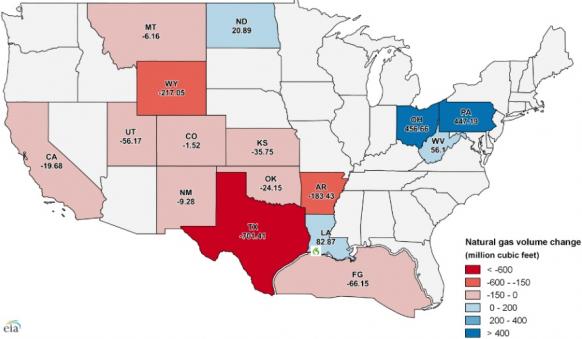US gas pipeline approvals stuck at 7 Bcf/yr; Annual gas output swings north
Our pick of the latest petrochemicals news you need to know.

Related Articles
US pipeline approvals stuck at 7 Bcf/yr until Trump builds FERC board
The U.S. Federal Energy Regulatory Commission (FERC) has approved more than 7 billion cubic feet per day (Bcf/d) of new gas pipeline projects in 2017 and requires new commissioners to grant pending approvals, the U.S. Energy Information Administration (EIA) said March 7.
Rising output from the Marcellus and Utica shale plays in the north-east are the main drivers behind new gas pipeline projects. In 2016, the FERC allocated certificates to 17.6 Bcf/d of new natural gas pipeline capacity.
"So far in 2017, FERC certificated more than 7 Bcf/d of new pipeline capacity before losing its quorum following the departure of one commissioner in February, which left just two sitting commissioners and three vacant seats," EIA said in a statement.
President Trump's administration is preparing to name new FERC commissioners, U.S. media reported March 9.
US FERC gas pipeline approvals in 2017

At the end of February, 33 pipeline projects were submitted to the FERC process, and 20 projects had submitted FERC pre-filings, according to data from PointLogic Energy.
"Consideration of these projects, among others, will be deferred until FERC has at least the three commissioners required to constitute a quorum," EIA said.
Major pipeline projects approved this year include the 3.3 Bcf/d Rover Pipeline which will transport gas from the Utica shale to states including Ohio, West Virginia, Michigan and Ontario.
The 1.7 Bcf/d Atlantic sunrise project will transport gas from the Marcellus Shale to markets in the mid-Atlantic and south-eastern states, EIA said.
Other projects which have recently been allocated certificates include the Orion Project, Transco to Charleston Project, Rayne and Leach Xpress, Northern Access, and Northern Lights 2017 Expansion.
FERC oversees the interstate transmission of natural gas, including the regulation of interstate transportation rates and services for natural gas pipelines, natural gas pipeline construction, and related environmental matters.
US gas production swings north on shale efficiencies, low prices
The U.S. saw a geographical shift in natural gas production in 2016, as output from northern shale gas plays hiked and traditional producing regions cut back following lower market prices, data from the EIA shows.
Natural gas gross withdrawals in the Lower 48 states fell by 1.3% in 2016, averaging 80.4 billion cubic feet per day (Bcf/d), EIA said. Gas withdrawals picked up in the second half of 2016 as gas prices recovered and prices are expected to increase in 2017 and 2018, EIA noted.
US gas production changes in 2016
(Click image to enlarge)
In Pennsylvania and Ohio, gas production increased in 2016 due to higher production from the Utica and Marcellus shale plays.
Shale gas efficiency improvements have helped increase output from Pennsylvania, Ohio and West Virginia, EIA said.
Iran petchem production forecast to rise 50% by 2020
Iran petrochemical production could rise by 28 million mt/yr by 2020, a rise of 50% on current levels, according to industry consultants AmanpourConsult.
Iran's ethylene production is expected to rise by 5 million mt/yr by 2020 while methanol production is expected to hike by 15 million mt/yr, Aman Amanpour said at S&P Global Platts European Petrochemical Conference in Dusseldorf on March 15. Propylene production is expected to rise by 5 million mt/yr with the remaining expansion made up from MEG, aromatics and derivatives units.
"The methanol figure of 15 million mt a year is particularly mind-boggling. It is high, but even if it is 10 million mt then it is huge and will have a big impact," Amanpour reportedly told the conference.
At least 4 million mt/year of new Iranian methanol capacity is due to come online in the next 12 months, S&P Global Platts reported.
Much of Iran's new methanol supply is expected to be exported to China, it said.
Petrochemical update

